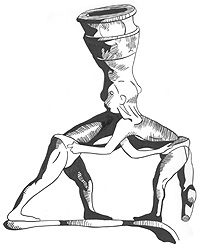Imbedded in every general history of the original 13 states are such misreported, misunderstood, anachronistic and conflated lines of misinformation such as these passages from chapters 4 and 5 of leaflet #44:
“There were few hired laborers during colonial [should read Plantation] times but apprentices and indentured laborers were common.”
These were never called indentured laborers, but servants, which held the identical dictionary meaning as slave. Many of these servants described themselves as slaves.
“Indentured laborers walked usually [flatly false, as most were kidnapped] to pay off a debt such as the cost of their passage to Pennsylvania from their home country such as England, Scotland, Ireland, or Germany.”
This was only true, in the main, of Germans post 1804, with that latter history grafted on the previous suffering masses between 1865 and 1913. It was technically true that all “freight” [adults] and “half-freight” [children] shipped to America were made to pay their passage, usually with years of hard labor and starvation, for the very practical reason, that once a boy or a girl [both terms having the English meaning slave] was abducted, purchased, hoodwinked, pressed, bound, sentenced or otherwise committed to the hold of a captain’s ship, that that captain would bill that slave with the cost of his own shipment, convert it to a purchase price, sell him to a master at anchor in an American bay or river, and the master would convert that price into years of labor owed to him. Likewise, in the case of folk who did pay for passage, any family member dying in transit would fall as a sentence of years of labor upon the spouse or child of the deceased.
“Apprenticeship was looked upon as not merely labor, but a form of education.”
This was education in slavery, with the child under 12 usually billed additional years of service for his supposed low productivity as a child, and in the case of short-terms of early teen service, the apprentice, such as Thomas Hellier and Benjamin Franklin, would be sold again as an older teen or adult. In Pennsylvania, according to Gottlieb Mitterberger in 1748, children were typically sold into service until age 31, which was a common rule across the various plantations.
The author then goes on to quote, William Penn, seemingly trusting anything attributed to Penn as being taken as benevolent, even though he blatantly arranged for a manorial system of serfdom by which Christian Congregationalists were served by catholics, and in which Germans and English were served by Scotts and Irish, with the Delaware Indians serving as paid slave catchers and plantation guards.
Chapter 5
“Only about 10 percent of African American slaves in Pennsylvania worked on Colonial farms: the majority of [African American] slaves worked in urban households as domestic workers.”
The 10 percent figure is true, demonstrating that 90% of unpaid, unfree labor in Pennsylvania was done by European American slaves. Also, be mindful, that less than 10% of Pennsylvania slaves were African Americans. In 1787, for instance, there were only 100 African American slaves in Philadelphia, it being illegal to hold an African American for more than six months in that city, while European Americans were typically held for periods ranging from 3 to 31 years. These were privileged household slaves and often even the lovers of the wealthy elite of Plantation society. Indeed, most urban slaves were European Americans working in locked work houses, as barmaids and as menial laborers. These were often supervised by the much more expensive and generally better-educated African American house servants.
“With certain farming regions, however, blacks were employed on farms. Samuel Hart of Bucks County said that in 1785, “I could stand on a corner of my farmer’s farm…and count sixteen farm houses, and in every house were slaves.”
The above quote is poorly sourced and can, preliminarily, be interpreted in various ways.
Hart did not say “black slaves” but “slaves.” Thus, his quote may be misunderstood as indicating African Americans only and not other slaves.
If Hart was an abolishionist of the time, who saw European American slavery as a due penance for religious heresy or penance due for the greatest crime of English Society, failure to thrive economically as an exploiter of other humans [the common meaning of liberty at the time,] yet abhorred African bondage, than he would have been accurately referring to the actual unfree occupants of plantation houses as African American slaves, as European American slaves generally slept in the barn, as they were much more expensive livestock, running for roughly 10 times the price of an Irishman, and like Governor Berkeley’s “negro” from the letter in Samuel Wiseman’s book of record in 1676, lorded it over their pale counterparts on behalf of their owners. Note that these slaves are placed “in every house,” where most African Americans in the Northern Plantations resided in bondage, not in the fields of toil where most European Americans served.
In either case, the author of the paper blended sloppy sourcing and anachronistic assumptions into a conflation of facts and falsehoods well-suited to obscuring the real past.
[Editor, please source Samuel Hart so that his statement may be examined in proper context.]
For the reader interested in real American history:
Explore Plantation America
Support Plantation America Research
To support this project and view some graphics go to:
link › patreon.com/jameslafond











